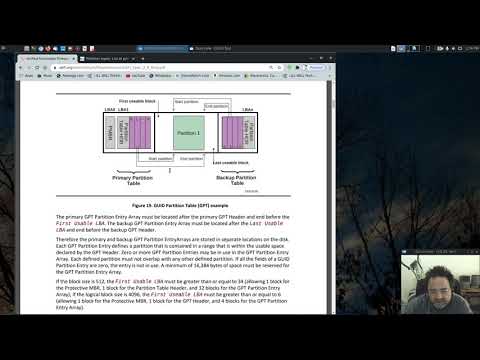Exactly. This is the core of my argument and also a sign if a distro’s philosophy allows for dual boot. Pop! for example does put their kernel in the EFI partition on purpose and they do it knowing that you would have to wipe your HDD or be savvy enough to create a second, larger FAT32 partition since their instalation demands >512 Mb to allow an install.
Pop! for example does put their kernel in the EFI partition on purpose
Doesn’t Pop! use systemd-boot? if so, that’s probably why.
Wikipedia is a quick way to check:
But you can check your own partition GUID with gdisk and get information on a partition. gdisk will show both the unique GUID and the partition type GUID. Most tools only show the unique GUID (like gparted, so that is useless in this case). blkid also is useless since it just shows the unique GUID.
As I have just used fdisk, blkid, and the like - I have never come across this before! Thanks for the information. I had thought that blkid had all the information, as it has both a UUID and a PARTUID… but not the case!
lsblk will also show those ID’s:
lsblk -o NAME,FSTYPE,UUID,PTUUID,PTTYPE,PARTTYPE,PARTTYPENAME,PARTUUID
-or shorter-
lsblk -o NAME,FSTYPE,PARTTYPE,PARTUUID
PARTTYPE = your “unique GUID” or gdisk’s “Partition GUID code”
PARTUUID = your “partition type GUID” or gdisk’s “Partition unique GUID”
That is excellent to know. Thank you 2000. 
But I think you mixed up the definition at the end.
If anyone is interested, this discussion inspired me to do a video about GUIDs and partitioning GPT disks.
Altogether, I do not see anyone giving the Source of why using /boot/efi is deprecated.
Arch WIKI only talks about “Typical mount points”
So what exactly is the issue?
I would more prefer to use systemd-boot for UEFI systems without grub at all or using rEFInd.
It isn’t deprecated. As far as I know it originates from this one comment in 2016.
However, this is related to systemd-boot, not grub. I would agree that mounting the esp at /boot/efi for systemd-boot does make very little sense.
In my opinion, there isn’t one.
It’s just Arch wanting to be different, it seems like. They even point out that every other distro is still using /boot/efi…
Edit: Having an /efi directory directly under / is actually making it more like Windows’ way of partitioning, oddly enough.
I think it is a more grub vs systemd-boot thing. A lot of the distros that use grub are using /boot/efi but that doesn’t make much sense for systemd-boot.
True, tho I think almost all Arch based distros use Grub too, thanks to using our favorite cephalopod installer.
As someone whose background includes installing Arch the Arch Way, it is pretty obvious that using systemd-boot is far simpler than using grub. The primary feature you loose is support for old MBR BIOS.
I did learn here that the installer used here defaults to using grub, which makes auto setting up of grub the easy path.
I have never tried anything but grub, so I wouldn’t know.
I agree. systemd-boot is way less complex and is my preferred choice. I think grub is quite a bit easier to deal with if you multi-boot though. That being said, I multi-boot 4 distros out of systemd-boot and it works great as long as you plan for it.
Reading the install instructions on the Arch Wiki and I must say it looks far more complex to set up than Grub…? So maybe it’s a matter more of what you are used to?
First, I think it is very easy to setup. For me, much easier than grub.
That being said, that isn’t what I meant by less complex. I didn’t mean easier to use, I meant that it introduces less complexity in the system. If you consider how easy to setup grub is, it isn’t very hard. However, what you are getting is automation to make a complicated thing seem easier. If you have looked through the actual generated grub config file you can see how complicated it really is. systemd-boot isn’t like that. It doesn’t have a lot of tools to automate it, it just isn’t complicated to begin with.
…In other words it is easier? I run “Arch the Arch way” atm and it took me two minutes to set up Grub and 30 seconds to create my own “update-grub” alias for
sudo grub-mkconfig -o /boot/grub/grub.cfg
…Anyway, that is neither here and there; I know Grub by heart so it is easy to set up for me and it works rock solid in my Dual boot and has done so since 2018 and a number of installs both thru Calamares, the Suse installer, the Fedora Installer, Pop! Installer and Cinchi as well as “The Arch Way”.
Edit: Anyway, that is not the point here. the point is that Arch has decided to leave a decades old standard behind for… reasons.
for sd-boot is kinda sudo bootctl update
i set my sd-boot to /boot , you will find the EFI folder of sd-boot… you can set it to /efi if you want also but you need a hook also for the kernel images…
also got some hooks also if a kernel is updated 
Yes the grub boot configuration is complicated. I find it difficult to deal with so I try not to have to.
